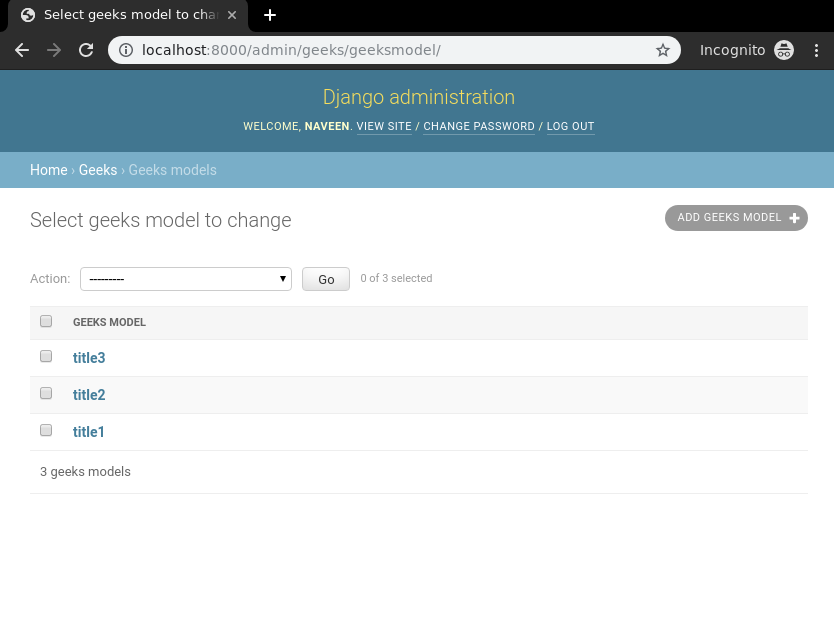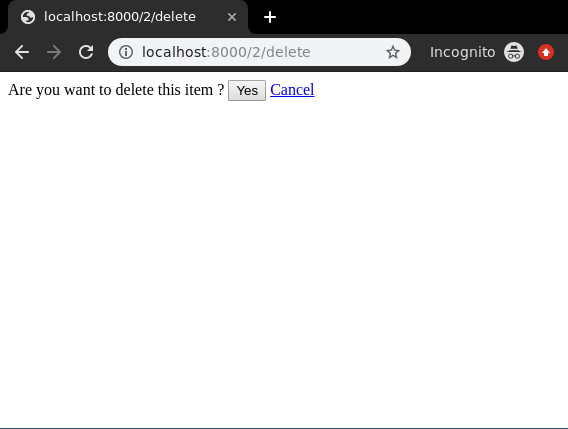Delete View – Function based Views Django
Last Updated :
17 May, 2021
Delete View refers to a view (logic) to delete a particular instance of a table from the database. It is used to delete entries in the database for example, deleting an article at geeksforgeeks. So Delete view must show a confirmation message to the user and should delete the instance automatically. Django provides extra-ordinary support for Delete Views but let’s check how it is done manually through a function-based view. This article revolves around Delete View which involves concepts such as Django Forms, Django Models.
For Delete View, we need a project with some models and multiple instances that we can use for deleting.
Django Delete View – Function Based Views
Illustration of How to create and use Delete view using an Example. Consider a project named geeksforgeeks having an app named geeks.
Refer to the following articles to check how to create a project and an app in Django.
After you have a project and an app, let’s create a model of which we will be creating instances through our view. In geeks/models.py,
Python3
from django.db import models
class GeeksModel(models.Model):
title = models.CharField(max_length = 200)
description = models.TextField()
def __str__(self):
return self.title
|
After creating this model, we need to run two commands in order to create Database for the same.
Python manage.py makemigrations
Python manage.py migrate
Now let’s create some instances of this model using shell, run form bash,
Python manage.py shell
Enter following commands
>>> from geeks.models import GeeksModel
>>> GeeksModel.objects.create(
title="title1",
description="description1").save()
>>> GeeksModel.objects.create(
title="title2",
description="description2").save()
>>> GeeksModel.objects.create(
title="title2",
description="description2").save()
Now we have everything ready for back end. Verify that instances have been created from http://localhost:8000/admin/geeks/geeksmodel/

Now let’s create our delete view first, In geeks/views.py
Python3
from django.shortcuts import (get_object_or_404,
render,
HttpResponseRedirect)
from .models import GeeksModel
def delete_view(request, id):
context ={}
obj = get_object_or_404(GeeksModel, id = id)
if request.method =="POST":
obj.delete()
return HttpResponseRedirect("/")
return render(request, "delete_view.html", context)
|
Now a url mapping to this view with a regular expression of id,
In geeks/urls.py
Python3
from django.urls import path
from .views import delete_view
urlpatterns = [
path('<id>/delete', delete_view ),
]
|
Template for delete view includes a simple form confirming whether user wants to delete the instance or not. In geeks/templates/delete_view.html,
HTML
<div class="main">
<form method="POST">
{% csrf_token %}
Are you want to delete this item ?
<input type="submit" value="Yes" />
<a href="/">Cancel </a>
</form>
</div>
|
Everything ready, now let’s check if it is working or not, visit http://localhost:8000/2/delete

Let’s check if instance has been deleted or not,

One can implement this view in any manner as per requirement using obj.delete() function.
Like Article
Suggest improvement
Share your thoughts in the comments
Please Login to comment...